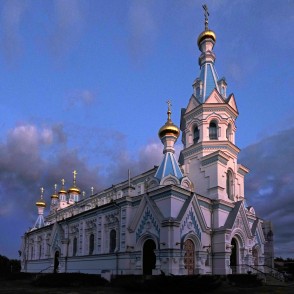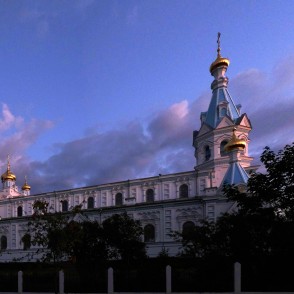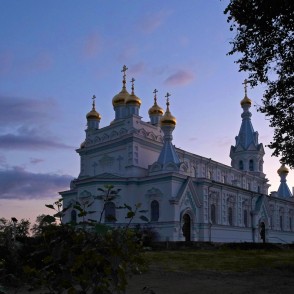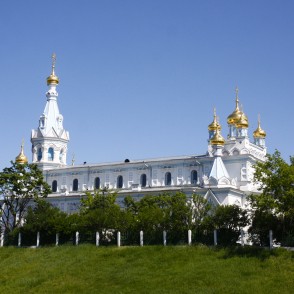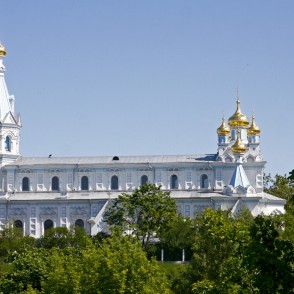In the place, where St.Boris and Gleb Orthodox Cathedral is located, in 1866 for army needs there was built an iron church. By order of the leaders of Polatsk eparchy in 1904 the church was moved to present-day Jersika (in Līvāni district).
St.Boris and Gleb Orthodox Cathedral was built in 1904-1905 and was consecrated on 12 June 1905. The architect of the cathedral is unknown, but building was financed by military department that dealt with religious questions of army.
St.Boris and Gleb Cathedral in its plan has the shape of oblong rectangle that is divided in three parts: noticeably higher middle nave and two side naves. Stone nave of the cathedral leans on foundation of granite block masonry. Cathedral’s span roof is covered with tin plates. The division in naves is reflected in cathedral’s external view – in side naves’ ends (in corners of the cathedral) there rise towers. In Eastern part of the heightened middle part of the building, on rectangle foundation, there are built 5 small towers. Above the entrance to the cathedral there is a belfry, which initially had four bells. At the moment cathedral’s towers are covered with purple tin roof and its cupolas are coloured blue, but in first half of the 20th century all ten towers had gilded cupolas and crosses. White-coloured building of the cathedral is very expressive – in its external view were used decorative elements of wedge-shaped arch, as well as eaves, columns, pediments, portals, etc. To make the decoration of the building even more impressive, here and there was used light blue coloration. Above the entrance to the cathedral there is placed the picture of the Christ, but its Southern facade is decorated with wall painting of Saint Boris and Gleb. External view of the cathedral, especially the outline of the shape of the decorative columns, relates to Russian architecture of turn of 19th and 20th centuries, in which under the influence of historicism could be seen the echo of Russian and Eastern art.
St.Boris and Gleb Cathedral in the sense of the use of numerous decorative elements is recognized as the most gorgeous orthodox cathedral of this region. Its building is justly considered as one of the most spacious, richly decorated and arranged orthodox cathedrals not only in Latgale, but also in whole Latvia.
www.visitdaugavpils.lv
The Saints Boris and Gleb Cathedral (Russian: Борисоглебский собор, Latvian: Svēto Borisa un Gļeba pareizticīgo katedrāle) is the main Orthodox church in Daugavpils, Latvia. It can hold 5,000 people, being the biggest Orthodox church in Latvia.
The cathedral is situated in Jaunbūve (Novoye Stroyenie) neighbourhood on the Church hill (Baznīckalns, Церковная горка), along with the Immaculate Conception Catholic Church, the Martin Luther Lutheran Cathedral, and the House of Prayer of Daugavpils First Old Believers' Community.
History
A previous church on the site was built in 1866 by the order of the Governor-General of the Northwestern Krai Konstantin von Kaufman for the needs of the local garrison and was consecrated in honour of the emperor Constantine I and his mother Helena. Usually referred to as the Iron church (Железная церковь, Dzelzs baznīca) because of its external cladding, it was dismantled and rebuilt at Tsargrad (now Jersika), where it still remains, following the decision to build a new garrison cathedral at the original site.
The contemporary church was built in 1904–1905, the construction work being financed by the military. It was consecrated on 25 July [O.S. 12 July] 1905 in honour of the Holy Righteous Princes and Passion-bearers Boris and Gleb and Saint Alexius, Metropolitan of Moscow.
Architecture
The church was built in the Neo-Russian style. It is a three-aisled masonry church, which on the plan forms an oblong rectangular with a polygonal apse and resembles a ship. The cathedral has ten towers with gilded cupolas. The interiors include murals and ceiling pieces.
It has been suggested that the icons on the oak iconostasis in the cathedral are copies of works by Viktor Vasnetsov in St. Vladimir's Cathedral, Kiev.
en.wikipedia.org

